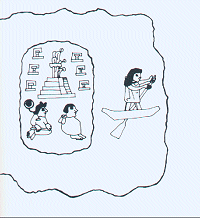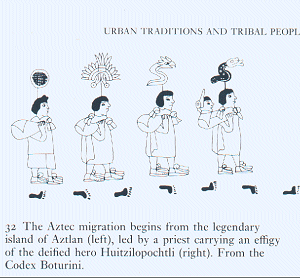
Of all the migrant groups, the early history of the Mexica is the most well known. The legend of Mexica migration goes as follows. Supposedly during the early 12th century a tribe departed from its ancestral homeland, described as an island within a lagoon somewhere to the north. The name of this place was Aztlan, meaning a place of cranes, from which the archaic name Aztec was taken. It was not until later during the migration that these peoples assumed the name Mexica by which they were known by the Spaniards. The original term Aztec reappeared again in scholarly studies of the 18th and 19th centuries, and is now accepted as a generic name for the people of the Valley of Mexico at the time of the Spanish Conquest.
The original Aztecs may have had some knowledge of agriculture, for it was not until after leaving their homeland that they were joined by a second group of nomad hunter-gatherers who called themselves Mexica. According to legend it was Huitzilopochtli who ordered the tribe to change its name and to carry the equipment of the nomad peoples. The tribe wandered on across the tablelands and mountain ranges, settling in favorable places for as long as 20 years before moving on to a newer location for another two or three years. Legend says that they even built temples and ballcourts at their longer stopping-places, yet they always did move on urged by a vision of destiny conveyed by Huitzilopochtli through his priestly mediums.
The legend continues by describing a series of tribal quarrels. A faction split from the main body followed by another more serious division when Huitzilopochtli's sister Malinalxochitl was abandoned with her group. These people are said to have made their way separately to found the town of Malinalco, deep in forested mountains. Huitzilopochtli's main group now faced a more serious challenge. The dramatic events at Coatepetl are described in metamorphic terms.
The Mexica left Coatepetl and made their way to Tula, where they camped among the ruins before continuing to the Valley of Mexico. When they arrived they made their way along the western lakeside, stopping briefly at Tenayuca before passing on by Aztzcapotzalco to arrive at Chapultepec, where they settled. The following period of about 25 years was a crucial one for the Mexica. They faced a hostile reception. The first threat came from a distant relative named Copil, who was the son of Huitzilopochtli's dissident sister Malinalxochitl. Copil began to intrigue among the older towns to throw out the newcomers. I the battle that followed the Mexica were driven from Chapultepec, although Copel himself was killed. According to legend his heart was cut out and thrown across the water to land on the island where Tenochtitlan would later be founded.

Leaving
Aztlan

Priestled
Migration